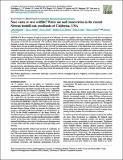Por favor, use este identificador para citar o enlazar a este item:
http://hdl.handle.net/10261/191475COMPARTIR / EXPORTAR:
 SHARE SHARE
 CORE
BASE CORE
BASE
|
|
| Visualizar otros formatos: MARC | Dublin Core | RDF | ORE | MODS | METS | DIDL | DATACITE | |

| Título: | Save water or save wildlife? Water use and conservation in the central Sierran foothill oak woodlands of California, USA |
Autor: | Huntsinger, Lynn; Hruska, Tracy V.; Oviedo Pro, José Luis CSIC ORCID; Shapero, Matthew W. K.; Nader, Glenn A.; Ingram, Roger S.; Beissinger, Steven R. | Palabras clave: | Agroforestry Conservation trade-offs Ecosystem services Endangered species Irrigation Social-ecological systems Water systems Wetlands |
Fecha de publicación: | 2017 | Editor: | Resilience Alliance | Citación: | Ecology and Society 22(2):12 (2017) | Resumen: | More frequent drought is projected for California. As water supplies constrict, and urban growth and out-migration spread to rural areas, trade-offs in water use for agriculture, biodiversity conservation, fire hazard reduction, residential development, and quality of life will be exacerbated. The California Black Rail (Laterallus jamaicensis coturniculus), state listed as “Threatened,” depends on leaks from antiquated irrigation district irrigation systems for much of its remnant small wetland habitat in the north central Sierra Nevada foothills. Residents of the 1295 km² foothill habitat distribution of the Black Rail were surveyed about water use. Results show that the most Black Rail habitat is owned by those purchasing water to irrigate pasture, a use that commonly creates wetlands from leaks and tailwater. Promoting wildlife, agricultural production, and preventing wildfire are common resident goals that call for abundant and inexpensive water; social and economic pressures encourage reduction in water use and the repair of leaks that benefit wildlife and greenery. Broad inflexible state interventions to curtail water use are likely to create a multitude of unintended consequences, including loss of biodiversity and environmental quality, and alienation of residents as valued ecosystem services literally dry up. Adaptive and proactive policies are needed that consider the linkages in the social-ecological system, are sensitive to local conditions, prevent landscape dewatering, and recognize the beneficial use of water to support ecosystem services such as wildlife habitat. Much Black Rail habitat is anthropogenic, created at the nexus of local governance, plentiful water, agricultural practices, historical events, and changing land uses. This history should be recognized and leveraged rather than ignored in a rush to “save” water by unraveling the social-ecological system that created the landscape. Policy and governance needs to identify and prioritize habitat areas to maintain during drought. | Versión del editor: | https://www.ecologyandsociety.org/vol22/iss2/art12/ | URI: | http://hdl.handle.net/10261/191475 | DOI: | 10.5751/ES-09217-220212 | ISSN: | 1708-3087 |
| Aparece en las colecciones: | (CCHS-IPP) Artículos |
Ficheros en este ítem:
| Fichero | Descripción | Tamaño | Formato | |
|---|---|---|---|---|
| Save water or save wildlife.pdf | 10,7 MB | Adobe PDF |  Visualizar/Abrir |
CORE Recommender
SCOPUSTM
Citations
15
checked on 29-mar-2024
WEB OF SCIENCETM
Citations
13
checked on 29-feb-2024
Page view(s)
243
checked on 22-abr-2024
Download(s)
166
checked on 22-abr-2024
Google ScholarTM
Check
Altmetric
Altmetric
Este item está licenciado bajo una Licencia Creative Commons



